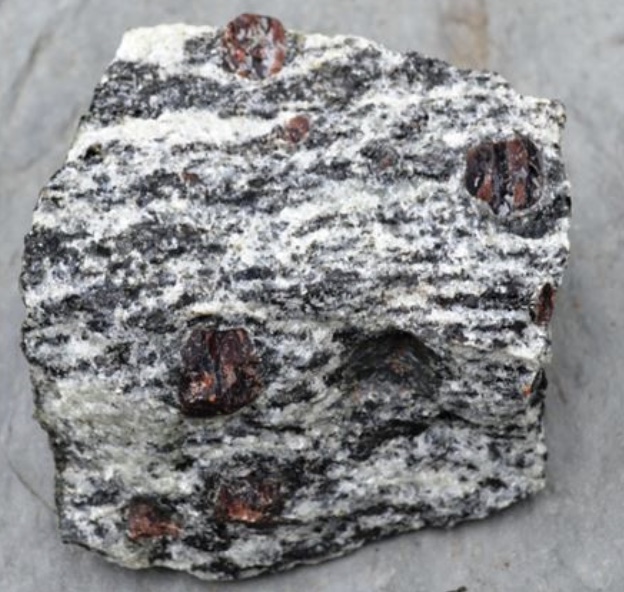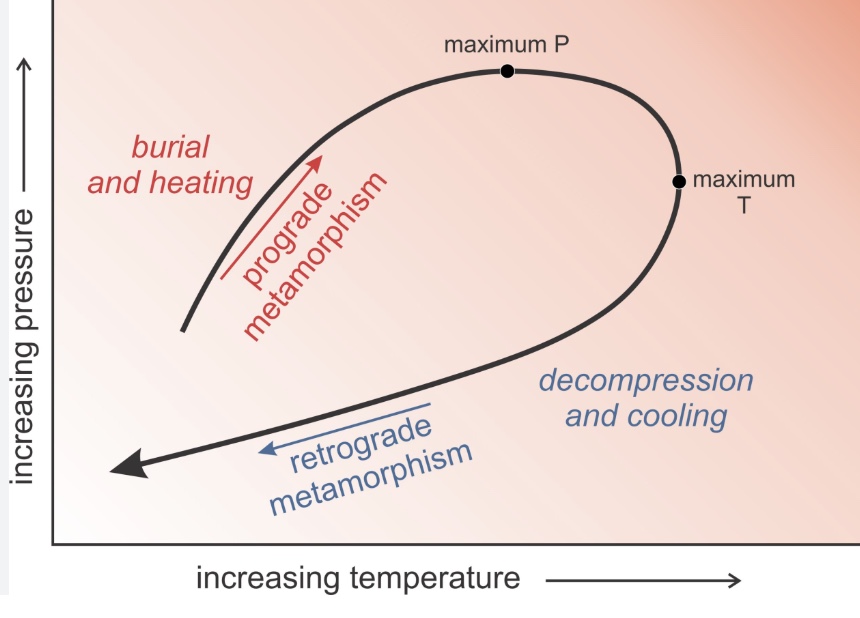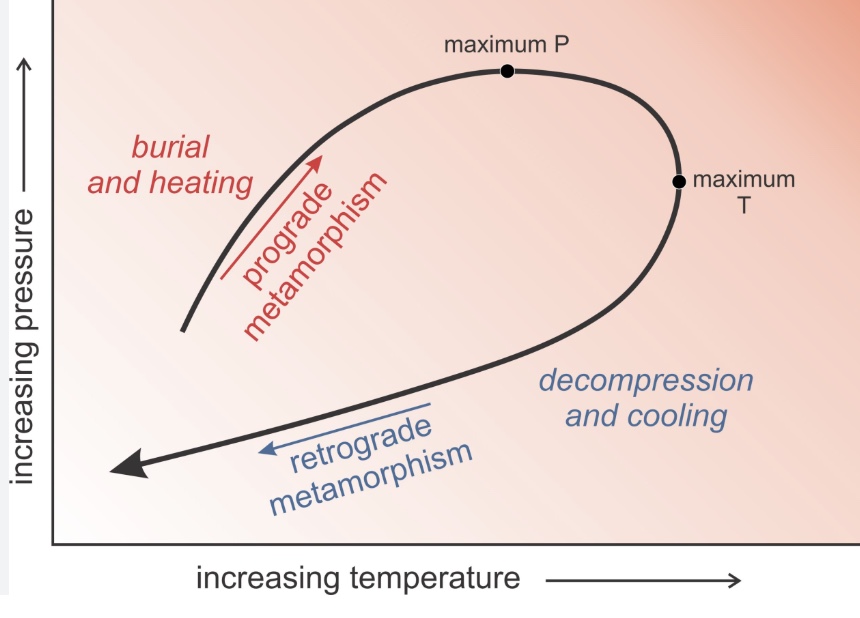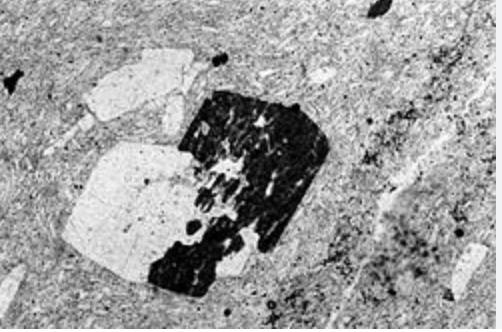Geology 302 Metamorphic Exam
1/48
There's no tags or description
Looks like no tags are added yet.
Name | Mastery | Learn | Test | Matching | Spaced |
|---|
No study sessions yet.
49 Terms
How are metamorphic rocks formed?
Metamorphic rocks form by the transformation of any rock type (igneous, sedimentary, and pre-
existing metamorphic rocks) due to changes in pressure/or temperature, and/or fluids
What is the metamorphic process?
The process by which existing rocks, known as protoliths, are transformed into new rocks with different mineral compositions and textures due to changes in temperature, pressure, and the addition or subtraction of fluids. Is sub solidus!!!!
Metamorphism grades into diagenesis (sedimentary rocks)
High - T, Low - P
Metamorphism grades into melting (igneous rocks)
High - T , High - P
Main types of metamorphic environments (4)
1. Subduction zones
2.)Contact metamorphism
3.) Hydrothermal fluid flow
4.) Orogenesis
Subduction Zones
Convergent plate boundaries where one tectonic plate slides beneath another, typically an oceanic plate beneath a continental plate or another oceanic plate

Contact Metamorphism
happens when rock is heated up by an intrusion of hot magma

Hydrothermal Fluid Flow
The circulation of hot water and dissolved minerals within the Earth's crust, typically driven by heat from magma or geothermal sources

2 main reactions between minerals
1. Chemical
2.) Polymorphic
Polymorphic Reaction
a solid-solid reaction where one mineral phase transforms into another with the same chemical composition but a different crystal structure

Chemical Reaction
These are reactions that occur to reach chemical equilibrium as a function of P, T, and fluids (typically H 2O and CO 2). This involves changes in mineral compositions and mineral assemblages.
Orogenesis
The process of mountain building, primarily through plate tectonics at convergent plate margins, where tectonic plates collide and compress

What controls temperature in the
thickened crust of an orogenic belt?
crustal heat production from radioactive decay, heat advection associated with deformation, and conductive heat flow
Porphyroblast
a metamorphic mineral,
Typically larger than the matrix mineral grain

Discontinuous Reaction
B+C=A+D
high-temperature mineral completely reacting with the cooling magma and dissolving to form a new mineral at a specific temperature. Each mineral forms at a distinct temperature, unlike the continuous series where plagioclase composition changes continuously
Continuous Reaction
Ass1=Ass 2+B
Ass 1+Bss 1=Ass 2+Bss 2
a type of chemical reaction that occurs over a range of temperatures and pressures, where at least one of the phases involved changes composition
Prograde Metamorphism
metamorphic reactions that occur with increasing temperature and pressure. This process involves changes in mineralogy and texture of a rock as it is subjected to progressively higher metamorphic conditions.

Retrograde Metamorphism
The geological process where high-temperature metamorphic rocks change into low-temperature rocks. This occurs when metamorphic rocks are subjected to decreasing temperatures and pressures, often during uplift or cooling after burial.

What is a linear fabric in metamorphic rock called?
Lineation
The presence of andalusite is indicative of metamorphism at
Low T and Low P
Phenocryst
a large, conspicuous crystal embedded in a finer-grained matrix or groundmass of an igneous rock, giving it a porphyritic texture

Porphyroclast
a mineral fragment or relict grain within a metamorphic rock that is larger than the surrounding, finer-grained matrix

What is expected during the metamorphism of mudstone
phyllite
Gneiss
slate
Metamorphism of calcareous rocks produces complex mineral assemblages when the protolith is
Calc-silicate
What is the reaction type that results in a tie-line flip on a ternary phase diagram
discontinuous reaction
Rocks that have undergone intense brittle deformation, resulting in angular clasts in a finer-grained matrix, are called what?
cataclasite
Rocks that have undergone ductile deformation, resulting in angular clasts in a finer-grained matrix, are called
mylonite
A metamorphic rock that has undergone partial melting is a
migmatite
Migmatites represent a transitional stage between metamorphic and igneous rocks, where intense heat and pressure have caused partial melting of the rock
What mineralogical changes occur during the subduction of mafic crust? Why does this contribute to the slab sinking?
Dehydration reactions lead to the slab sinking. These changes involve minerals like lawsonite, chlorite, and amphiboles, which release water as they transform under pressure and temperature. This water release contributes to the slab's overall density and density contrast with the surrounding mantle, driving its descent.
What happens to the water that is released when hydrous minerals break down during metamorphism?
Why does this matter for retrograde metamorphism?
Why is this important for subduction zone magmatism?
Water can be incorporated into new minerals, migrate through the rock, or be lost from the system. This released water is crucial for retrograde metamorphism because it facilitates mineral reactions at lower temperatures and pressures. For subduction zone magmatism, the water released from the subducting slab lowers the melting point of mantle rock because it is now denser.
Why are continuous reactions useful for understanding the tectonic history of a metamorphic terrain? (Include examples of minerals that can and cannot undergo continuous reactions.)
By allowing geologists to reconstruct the pressure and temperature conditions under which metamorphic rocks formed. These reactions, unlike discontinuous reactions, involve changes in mineral composition rather than the complete replacement of one mineral by another. By analyzing which minerals are present and what exchange reactions have occurred, geologists can infer the depth and the geological environment in which a metamorphic terrain was formed
Can - Plag, Pyroxene,
Cannot - Quarts, Micas
Why does metamorphism of arkosic sandstone produce a more complex metamorphic assemblage than metamorphism of pure sandstone? (include an example of the rock produced by metamorphism of both rock types)
Metamorphism of arkosic sandstone, which contains feldspar and other minerals besides quartz, produces a more complex metamorphic assemblage than metamorphism of pure sandstone (quartz arenite) due to the presence of multiple unstable minerals. As metamorphism progresses, these unstable minerals react with each other and with the surrounding minerals to form new, stable metamorphic assemblages, leading to a diverse range of metamorphic rocks.
Pure sandstone, primarily composed of quartz, undergoes less complex changes, typically resulting in quartzite
arkosic sandstone results in schist and gneiss
What kind of rocks can be protoliths?
Sedimentary, Metamorphic, Igneous
What is the most important factor for determining what kinds of metamorphic rocks and minerals are formed?
The protolith composition
What is the most important factor for determining the degree of metamorphism that particular rocks undergo?
Temperature (reactions take time), more important than pressure, bc reactions are more temperature dependent
What is the typical pressure from overlying rock that causes metamorphism?
less than 10 kbars
Metamorphic reactions are
Sub - solidus (if it gets to really high temps it will make an igneous rock)
What type of reaction leads from andalusite to kyanite to sillimanite?
Polymorphic reaction
What is a key reaction of pelite metamorphism?
Dehydration reaction
Where is disequilibrium most common?
Lower temperature (not enough driving force for the reaction)
Metamorphism of mafic rocks is characterized by
A small number of minerals with a wide range of compositions (pellites have a large number of mineral assemblages)
What is the main reason that phase changes occur during metamorphism?
To reduce chemical energy
What is the main reason that physical changes occur during metamorphism?
to reduce physical energy
What is not a type of metamorphic fabric?
Bedding (foliation, gneissic banding, and crenulation are)
What is a pseudomorph?
The original shape is maintained but completely changed to another mineral (chlorite replaces garnet)
What is a facies?
a distinctive rock unit or group of rocks characterized by specific features like composition, texture, or sedimentary structures, reflecting the conditions of its formation and depositional environment
What are the 2 types of metamorphic reactions?
Chemical Reaction - become stable, to reach chemical equilibrium, as a function of T-P and fluids, change in mineral composition, and assemblages
Polymorphic Reaction - comp does not change, but increasing P-T gives a new stable mineral structure
What is Protolith (Pelites: mudstone/shale)? How are they formed? Where does it come from?
A protolith is the original, unmetamorphosed rock that undergoes metamorphism to become a metamorphic rock. In the case of pelites, which include mudstone and shale, the protoliths are typically fine-grained sedimentary rocks composed of clay minerals, often derived from the weathering and erosion of continental crust
What is the difference between porphyroblast and porphyroclast
Porphyroblasts are large crystals that grow within a finer-grained matrix during or after deformation, whereas porphyroclasts are large crystals that predate deformation and have been preserved within the finer matrix.